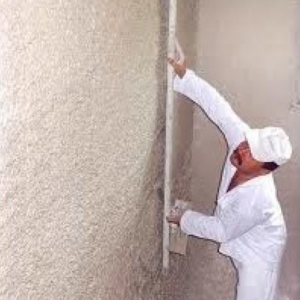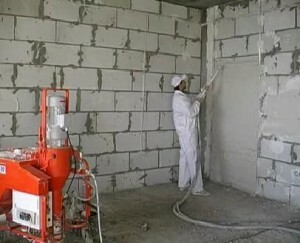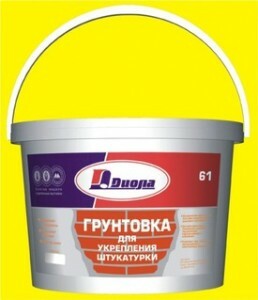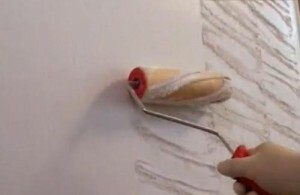Consumption of plaster: features, characteristics, and applying the mixture
Table of contents
-
1 Features and Specifications
- 1.1 Structure
- 1.2 Scope of use
- 2 Applying the mix
- 3 Is it possible to put the tiles on the plaster of plaster?
- 4 Summing up
This modern form of finished industrial plasters used for the preparation of masonry, plaster, concrete and foam concrete, mineral surfaces. The consumption of gypsum plaster in 2 times less than the traditional counterparts.

Features and Specifications
When the thickness of the plaster layer 1 cm flow plaster to 1 m is approximately 8.5 kg. It is worth noting that you may need as much as, or less than mixtures for leveling walls.
The layer thickness can be found out by means of staking surfaces and determine their irregularities. If the walls have only a small defect, the layer thickness can be reduced to 0.5 cm.
Structure

The application of plaster mechanized method
The composition includes a binder plasters - mineral gypsum and special modifiers that enhance adhesion. Therefore, these types of plasters specially recommended for smooth bases poorly water absorbent, such as concrete.
Scope of use
Gypsum products are designed to work inside buildings in rooms with normal humidity, but can also be used in bathrooms and kitchens.
The prepared solution during plastering delaminate, while spraying on the porous coating is dehydrated.
Gypsum has ecological purity, so creating a balanced microclimate in the premises and the right humidity mode.
Applying the mix

Fiberglass reinforcing mesh
Before you start plastering It is necessary to prepare the wall for plaster. On the base removed all loose materials on the walls are washed as needed.
- In operation, with the walls having a porous structure (foam concrete, bricks, blocks gas silicate, gypsum fiber board), an insulating coating is applied. If the substrate has high density and smoothness (concrete, cement) is used primer which increases the adhesion.
- Surface having a small strength (plasterboard, polystyrene), reinforcing the soil treated. The compositions can be applied by brush, roller or spray in two layers.
- In a clean container, pour water at the rate of 18 liters per 30 kg (standard packing) with a dry mixture. Add it 5-7 Kovshikov plaster and mix. The water sprinkle the remaining mixture and stir mixer until creamy solution without lumps. Soak it for 5-7 minutes and then stir again.
- The finished mixture is suitable for use for 20-25 minutes.
Methods for plastering walls and ceilings are different. Solution is applied to the ceiling over a falcon movements. On the walls of the solution pounces scoop and leveled regulation undulating or smeared float / trowel.
If you want to align the wall, on which there is a strong unevenness, the first has not yet dried up work through the solution layer tongue and wait until it is completely dry. Plaster treat the primer and the next layer applied mixture.
Note! Ceilings can plaster only in one layer.
When applying a plaster solution on the sheet materials to be applied plaster fiberglass mesh. It has a cell size of 0.5 × 0.5 cm, provides additional adhesion and reinforces the surface.
After the plaster mixture starts to set, as it occurs for 45-60 minutes start align wall. Do this a wide spatula and trapezoidal rack, lifting the mixture up in zigzags, it will cut off any excess mixture and fill all depressions.
All the irregularities formed on the inner and outer corners as well as plastered slopes cut the plaster plane.
If the surface to prepare the painting or wallpapering by making a small pause (15 minutes), it is necessary to overwrite solution. Wall good water soak and circular movements powertrowel float with felt glued or rigid porous sponge. So you raze the remaining irregularities and traces of rails and a wide spatula.
If you want to get a glossy finish, smooth out the wall already nipped steel float / trowel or a wide spatula. Your movements should be thus as large as possible.
That the resulting surface is perfectly flat and glossy, it is necessary for a day 3-4 times to produce wetting the walls with water and repeat the smoothing process.
Immediately it should be noted that the materials are not all manufacturers can be processed in this way. So the question arises: what plaster is better?
Among foreign manufacturers released the German company "Knauf", who had become a legend in the world of building materials. it may be noted "miners" and «Baustrol» among domestic companies.
Is it possible to put the tiles on the plaster of plaster?

Primer for plaster (the price - from 430 rubles).
Yes, it is quite possible. Once the plaster is completely dry, it can be oblitsevat ceramic tiles.
It is fixed by a special tile adhesive. Pre-plastering the walls with their hands should be treated with primer deep penetration. If the room has a high moisture content, it is recommended to use a waterproofing primer.
Primers for surfaces made of gypsum-based synthetic resin emulsions.
Material Features:
- reduces porosity and absorbent properties of gypsum surfaces;
- cladding provides adhesion to the substrate;
- prevents cracks;
- It forms a strong and elastic film;
- increases the water resistance of gypsum base;
- It is completely ready to use material;
Instructions for the preparation of primers with your hands:
- Before you will be made laying tiles on gypsum plaster, wall surfaces must be cleaned and sanded. Anhydrite surface must be completely dry (moisture indicators - less than 0.5%). The temperature of the substrate surface - not less than +5 ° C.
- Mix well before use primer.
- Evenly distribute the mixture over the surface being treated with a roller or brush.
- Gypsum has high absorption rates, therefore, would require application of at least two layers of soil.
By subsequent tiling proceed only after the mixture was completely dry.
Summing up
Now that you know how to use plaster. In order to more accurately understand the technological and practical issues on our website provides detailed photo and video instruction, in which you will find the necessary information on the question.


